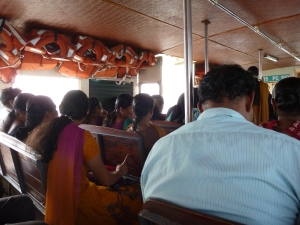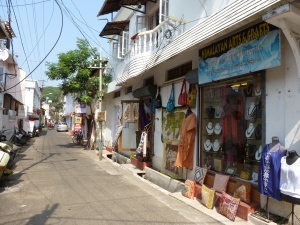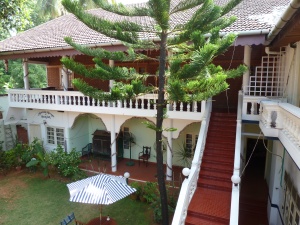Kochi is the best place for Westerners to start a jaunt around Southern India. Blessed with clean streets (rare in India) of whitewashed buildings, it is easy and safe to navigate around on foot on one’s own, very tourist friendly to the point that purist Indianophiles (if there is such a title) would say ‘too’ touristy. Fort Cochin has an abundance of well preserved architecture of Portuguese, Dutch and British influence reflecting its colonial history. Just being in the town took me back to the India of my childhood. Walking to the point of exhaustion around the small streets, lined with shops displaying their merchandise inside and out in the balmy January weather, I basked in my memories . Winter (December-March) is definitely the time to go to the subcontinent.
Fortuitously, for the two days prior to my joining my Intrepid Travel group, I picked the small Fort Heritage Hotel. It came with a history all its own. Built by the Dutch East India Company in 1668, the natives originally called it Kannadikottaram, meaning Palace of Glass; not sure why, for the building did not have any more glass than any other around. Upon their conquest of the area, the British took possession of the building for the Navy. Since then it has passed through the hands of several locally renowned families until its current Heritage Star Classification.
Breakfast was taken in a pleasant central courtyard onto which my room looked. The western style bathroom also contained a washtub and scoop, presumably preferred for washing by Indian guests, the shampoo was labelled moisturiser, the fridge kept blowing the switch, the fan creaked abominably, as did the bathroom door, but the room had all the ambiance of old colonial splendour on a small scale.
I had to evict a monkey sneaking across my bed who had taken the advantage of the open veranda door to investigate the possibility of a snack, while I was typing my journal in an attached alcove. It was not well pleased for it took to smashing ashtrays and items of pottery on the neighbouring veranda for the next ten minutes. From thereonin the door had to remain closed but the little varmint woke me at 5am the next day, knocking on the window to request readmission.
Among the musts around Fort Cochin are the Chinese fishing nets along the foreshore. Brought here by Kubla Khan, the frame of the net hangs over the water at the end of a long beam, from the other end of which hang several rock counterweights. The net is submerged in the sea and subsequently hauled up posse of up to eight men on the weighted end chanting as they go. The catch is tipped into a large basket and sold in the market stall on the adjoining pavement.
The spice trade developed Fort Chochin into a thriving centre and many of the original godowns or warehouses are still in evidence today with a cacophony of spice markets, especially in the Jewish area of Mattencherry, which is also renowned for its antique shops. The Mattencherry Palace, also called the Dutch Palace, is well worth a visit.
My other wanderings took me to the lovely old church of St Francis, where Vasco da Gama was originally buried before his remains were returned to Portugal. It still sports the original punkahs (the hand fans, long cloth used in colonial times operated by servants outside pulling ropes back and forth through the walls).
The main city of the area and the one into which one flies is Ernakulam, not worth a visit in hindsight, except for the opportunity to catch the local ferry back to Fort Cochin. Feeling somewhat vulnerable at being the only female in the long queue snaking through the building to an empty ticket office (and one of only two European faces) thereby getting more than my fair share of curious stares, I was considering my position perhaps untenable. Fortunately, some kind soul pointed out that I was in the male queue and should reposition in the female one to one side of the building. Incurring more stares and feeling more than a little foolish, I moved to the tine line of ladies, an advantage in itself, with only about eight people before me. Purchase of the tickets wasn’t so simple. The note I offered was rejected with a voluble outburst of Hindi and much wagging of head and hands. Fortunately, I had some small (very small) change which was accepted. No wonder the official was a bit grumpy. For a few rupees (less than 20c), I clutched my ticket for the half hour journey and boarded the craft, having fended off a pushy request from a man in the male queue demanding that I buy his tickets as well so he could queue jump. Apparently each passenger can only buy two tickets and my lack of Hindi meant that I had not understood that I could have bought his ticket with mine and saved him waiting. Being a tourist makes one a great target! It was a pleasant ride along the inlet, stopping off at two places, back to Fort Cochin.
Purchase of the tickets wasn’t so simple. The note I offered was rejected with a voluble outburst of Hindi and much wagging of head and hands. Fortunately, I had some small (very small) change which was accepted. No wonder the official was a bit grumpy. For a few rupees (less than 20c), I clutched my ticket for the half hour journey and boarded the craft, having fended off a pushy request from a man in the male queue demanding that I buy his tickets as well so he could queue jump. Apparently each passenger can only buy two tickets and my lack of Hindi meant that I had not understood that I could have bought his ticket with mine and saved him waiting. Being a tourist makes one a great target! It was a pleasant ride along the inlet, stopping off at two places, back to Fort Cochin.
A visit to Kochi would not be complete without a visit to a Kathkali show. Described in Wikepedia as a ‘highly stylized classical Indian dance-drama noted for the attractive make-op of characters, elaborate costumes, detailed gestures and well-defined body movements present in tune with the anchor playback music and complementary percussion.’ It is mandatory to arrive well before the performance to see the application of the multilayer and colourfully bright makeup. Elaborate chalk patterns are drawn on the floors of the audience area. The amazing control of the facial muscles to produce subtle expression changes, all of which mean something individual, is fascinating. The curtain is a hand held sheet of silk used to screen scene changes. An elaborate drama of good over evil unfolds before one’s eyes, a performance not to be missed.


























